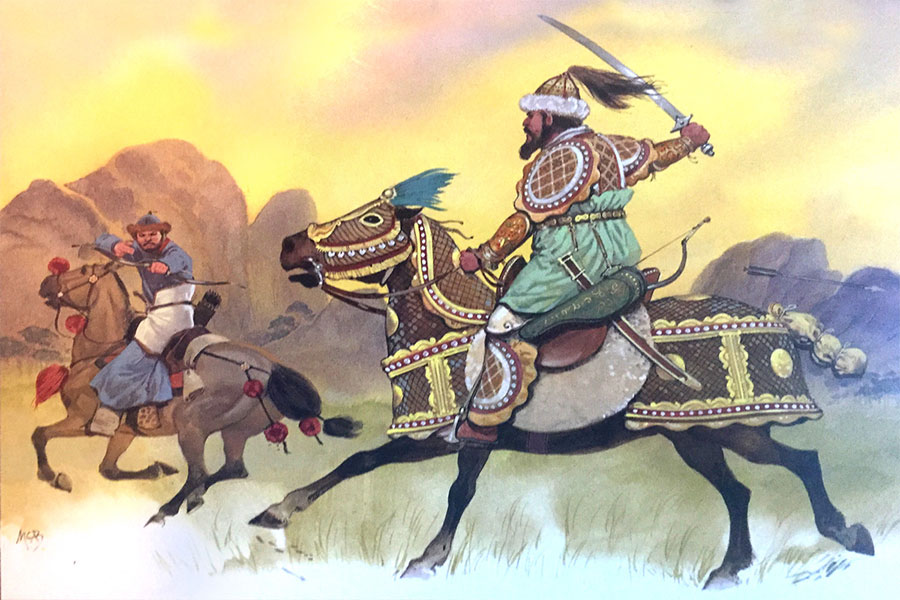One of the most important rebels in Chinese history: Who is An Lu-Shan?
An unpopular commander and ruler in Chinese history, who was admired for his intelligence and combativeness.

An Lu-shan is a Turkish-Sogdian hybrid commander who is disliked in Chinese history but admired for his intelligence and combativeness. Inheriting his warriors from his Turkish mother's genes and his cunning from his Sogdian father, this Chinese commander put into practice a plan that he had elaborated, patiently and meticulously for many years, in 755, with a huge army of 200,000 people, and eventually captured China and established the Great Yen State around today's Beijing. During this state, which lived for only eight years, China lost its capital and almost all of its lands in the northeast. This situation caused China not only to lose territory but also to understand that all the administration and administrative forms applied until that day were insufficient. This revolt caused the Tang Dynasty, which had reached its peak with an extraordinary rise, to realize that it was too late even to wake up from complacency. The Chinese population, which was 56 million before the revolt, decreased to 17 million 8 years later. In summary, the 137-year rising period was interrupted by this revolt, and when the revolt was over, the Tang Dynasty entered a period of slow but definite collapse that would last for a century and a half.
An Lushan, Wade-Giles romanization An Lu-shan, original surname Kang, imperial name Xiongwu, (born 703, Yingzhou [now Chaoyang, Liaoning province], China—died 757, Luoyang, Henan province), Chinese general of Iranian and Turkish descent. The family name An was derived from the Chinese name for Bukhara in Sogdiana (present-day Uzbekistan). An Lushan’s ancestors belonged to a group of Sogdians who had been incorporated into the Eastern Turks, and his mother was from a noble Turkish clan.
Life story
(703-757) Chinese commander. While an officer in the Chinese army, he overthrew the T'ang dynasty and became emperor for a short time. He came from an Uzbek family fused with the Eastern Turks. When the internal turmoil started after the death of Kapağan Kagan, the ruler of the Eastern Turks, in 716, the An family took refuge in China. In accordance with the border policy of the Chinese Empire, foreign soldiers were stationed at the borders. An Lushan entered the Chinese army and was stationed on the northeastern border. It was during the reign of Prime Minister Li Lin-fu that he rose in the army. He organized many expeditions against the Khitans, who were constantly raiding the northeastern border. He suffered a major defeat in 737. For this reason, he was sentenced to death but was later pardoned.
In 742 he became military administrator of the northeastern P'ing-lu region. During these years, he frequently visited the capital, establishing good relations with Prime Minister Li Lin-fu and gaining his trust. His campaign against Kitan in 751 ended in a great defeat. But due to his good relations with the palace, he was able to save his life as well as preserve his military duties.
When Li Lin-fu died in 752, a struggle ensued between those who wanted to take control of both the imperial court and the border areas. The aging emperor Hsüantsung was not strong enough to put an end to this turmoil. An Lu-Shan became the most powerful commander in the empire, taking the three border regions under his command.
Revolting against the T'ang dynasty in the winter of 755-756, he marched on the capital with his army, and the emperor fled to the southwest. An Lu-Shan proclaimed himself emperor of the Great Yen dynasty in 756. Although he took the capital, he did not enter the city and remained in the city of Lo-yang. He was killed by his own son in 757.
After An Lu-Shan's death, the rebel movement continued. However, these movements were suppressed in 763 with the help of the Uyghurs, who were traditional allies of the T'ang dynasty and replaced the Eastern Turks. Apart from the interruption caused by the rebellion of An Lu-Shan, the T'ang dynasty ruled China between 618 and 907, and there were important developments in China's cultural and political life during this period.
However, the rebellion led to the weakening of China, both internally and externally. The central government began to loosen and the first signs of a new social structure began to appear. With the end of the T'ang dynasty in 907, China was divided into ten separate regional states, and only in 960 was it reunited by the Sungs to create a new social organization. Therefore, An Lu-Shan's rebellion is considered a dividing line between these two eras.
